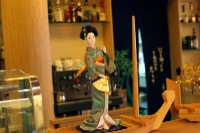The Fine Art of Kabuki Theatre
Fun Trivia Kabuki is a form of traditional Japanese theatre, most commonly known for the stylization of its drama, and for the complex makeup that is worn by its actors. A derivative of the verb ˜kabuku,’ which can be translated as meaning either œto learn or œto be out of the ordinary, kabuki can be loosely translated to mean either œavant-garde or œbizarre theatre. Regardless of how out of the ordinary kabuki may be, people still flock to watch the shows, year after year.
Kabuki is a form of traditional Japanese theatre, most commonly known for the stylization of its drama, and for the complex makeup that is worn by its actors. A derivative of the verb ˜kabuku,’ which can be translated as meaning either œto learn or œto be out of the ordinary, kabuki can be loosely translated to mean either œavant-garde or œbizarre theatre. Regardless of how out of the ordinary kabuki may be, people still flock to watch the shows, year after year.
The history of the fascinating art form began as far back as 1603 A.D., when female actors took to the stage and played both the male and female roles, in plays that portrayed ordinary Japanese characters, living their every-day lives. In 1629, however, this would all change when women were suddenly banned from the stage, in a movement that was designed to protect public morals.
Rather than lose this traditional form of theater, though, young male actors took to the stage instead. Playing both the roles of male and female characters alike, this would be allowed until the year of 1652. This time, the young male actors would be banned by the shogunate, and only mature men would be allowed to perform on the kabuki stages.
Despite the occasional alterations made between the years of 1673 and 1735, during the Genroku era, kabuki flourished and the configuration of a kabuki play was formalized, much like many other elements of stylization. This would remain so, up until the time when tremendous cultural changes began to occur in 1868; the fall of the Tokugawa shogunate, the opening of Japan to the Western world, and the elimination of the samurai class. All of these events would leave their marks upon kabuki theatre.
Still, there were more changes on the horizon. During World War II, many kabuki houses were destroyed due to bombing, and the occupying forces temporarily banned this form of theatre performance, following the war. In 1947, however, the ban was finally lifted and, once again, kabuki actors took to the stage. Today, even in modern Japan, this ancient art form is still popular with the people and its star actors often advance on to careers in television or on the silver screen.
Featuring a ˜hanamichi,’ or walkway which extends far out into the audience, as well as a ˜via’ to accommodate dramatic entrances and exits, technological advances have allowed kabuki theatre to grow even more. Today, one can expect trap doors and revolving stages, allowing actors to appear and disappear in an instant, the same dramatic makeup and the same costumes that have been worn throughout the ages. Staying true to form as ˜bizarre’ theatre, these are just a couple of the wonderful sights and cunning stage tricks that have evolved and flourished on the kabuki stage.
